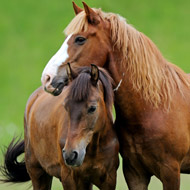Saliva test shown to reduce anthelmintic use in horses

The EquiSal Tapeworm saliva test accurately diagnoses horses with a tapeworm infection.
A targeted treatment strategy using a tapeworm saliva test has been shown to control tapeworm burdens and significantly reduce the use of anti-tapeworm anthelmintics.
The Equine Veterinary Journal study reports findings from 237 horses at UK welfare charity, Bransby Horses, where EquiSal Tapeworm saliva testing was used to inform anthelmintic administration over a year.
This diagnostic approach led to the reduced use of anti-tapeworm treatments by 86 per cent compared to six monthly interval treatment strategies.
The EquiSal Tapeworm saliva test accurately diagnoses horses with a tapeworm infection, providing a low, borderline or moderate/high diagnosis. Treatment is recommended for horses with a borderline or moderate/high result.
In this latest study, most horses diagnosed below the treatment threshold in the first saliva test remained below the threshold in the following two tests. 168 horses (71 per cent) required no anti-tapeworm treatment at all.
No increase in tapeworm infection prevalence was observed during the study period and only seven horses received treatment following all three saliva tests.



 The Federation of Independent Veterinary practices (FIVP) has announced a third season of its podcast, Practice Matters.
The Federation of Independent Veterinary practices (FIVP) has announced a third season of its podcast, Practice Matters.